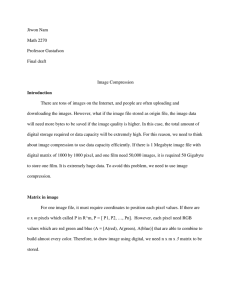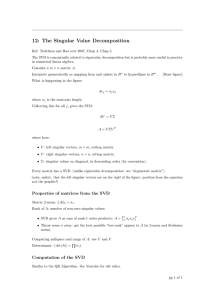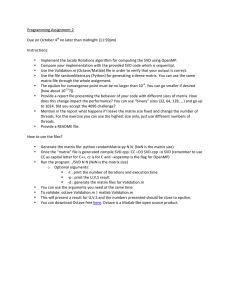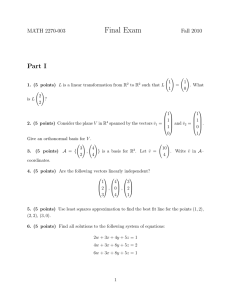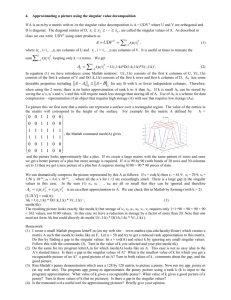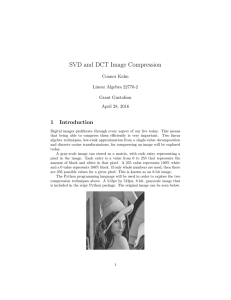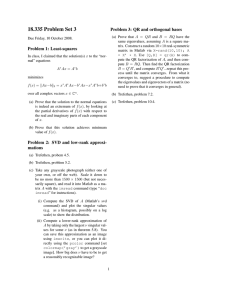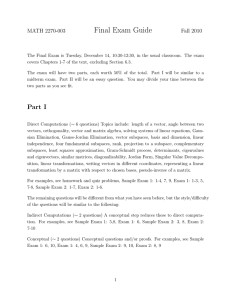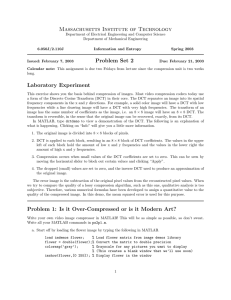Image Compression using SVD and DCT Math 2270-003 Spring 2012
advertisement
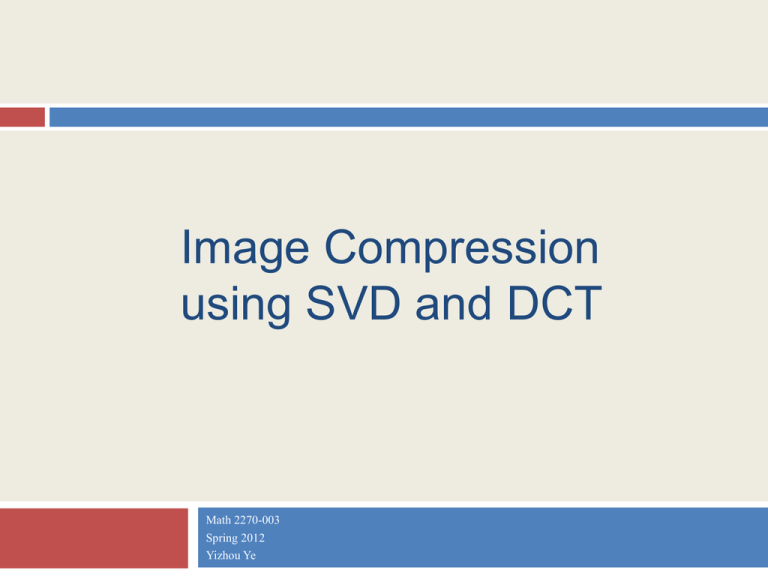
Image Compression
using SVD and DCT
Math 2270-003
Spring 2012
Yizhou Ye
Image? Matrix?
Matrix?
Notes
Image File = Header + RGB / GrayScale
Maple / Matlab what do they do?
Matlab API
A = imread(filename, fmt) reads a grayscale or
color image from the file specified by the
string filename.
The return value A is an array containing the image
data. If the file contains a grayscale image, A is an
M-by-N array. If the file contains a true-color
image, A is an M-by-N-by-3 array.
.jpeg, .jpg
Image == matrix? No.
Approximate way
Basically
Read Image
Matrix
SVD / DCT
done/ compressed
SVD
SVD: singular value decomposition
SVD
Note that A is m*n, U is m*m orthogonal matrix, Σ
is an m*n matrix containing singular values of A,
and V is an r*r orthogonal matrix. And the singular
values of A are:
All these singular values are along the main
diagonal of Σ.
We can rewrite the formula in the following way:
SVD
Approximation
Approximation of SVD is the most crucial part:
We know that the terms {Ai} are ordered from greatest to
lowest, thus we can approximate A by varying the number
of items. In other words, we can change the rank of A to
make the approximation (of course, larger number gives us
a more accurate approximation).
Example:
One term
Three terms
Examples:
10 terms
50 terms
Examples:
100 terms
300 terms
Examples:
300 terms (rank)
Original image
Issues
Compression Ratio:
Not exactly (1+m+n) / (m*n) for a m*n A
This plot is draw by matlab: Image is more complex
than we thought
MatLab Read original size:
Just the RGB / GrayScaler
24206
Ratio
Ratio
1.2
1
0.8
Ratio
0.6
0.4
0.2
0
# of terms
Cost of items
Cost of one term
1600
1400
1200
1000
800
byte
600
400
200
0
-200
index of terms
DCT
“Discrete Cosine Transformation”, which works by separate
image into parts of different frequencies.
A “lossy” compression, because during a step called
“quantization”, where parts of compression occur, the less
important frequencies will be discarded. Later in the
“recombine parts” step, which is known as decompression
step, some little distortion will occur, but it will be somehow
adjusted in further steps.
DCT Equations
i, j are indices of the ij-th entry of the image
matrix, p(x, y) is the matrix element in that
entry, and N is the size of the block we are
working on.
8 * 8 blocks
For a standard procedure where N=8, the
equation can be also written as the following
form:
T matrix
Procedure
Break the image matrix into 8*8 pixel blocks
Applying DCT equations to each block in level
order
Each block is compressed through
quantization
Basically done.
When desired, it can be decompressed, by
Inverse Discrete Cosine Transformation.
Example of DCT
-128 for each entry
Since pixels are valued from -128 to 127
Apply D = TMT’
T matrix is from the previous equations.
Human eye fact
The human eye is fairly good at seeing small
differences in brightness over a relatively large
area
But not so good at distinguishing the exact
strength of a high frequency (rapidly varying)
brightness variation.
We know the fact, then
This fact allows one to reduce the amount of information
required by ignoring the high frequency components. This is
done by simply dividing each component in the frequency
domain by a constant for that component, and then rounding to
the nearest integer.
This is the main lossy operation in the whole process. As a result
of this, it is typically the case that many of the higher frequency
components are rounded to zero, and many of the rest become
small positive or negative numbers.
Quantization Matrix
Quantization
quantization level = 50, a common choice of
Q matrix
Round Equation
Typically, upper left corner. Thus we apply zig-zag order:
Zip-Zag Ordering
Original VS. Decompressed
Examples
More Examples
Finale
Image can be expressed by matrix somehow, but
image is much more than that.
SVD and DCT are techniques to compress image,
but both of them are “lossy”.
Still many other ways to compress:
Thank you!
